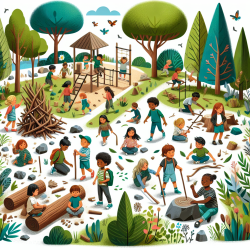Welcome to the Wonderful World of Natural Playspaces!
As a practitioner working with young children, you have a unique opportunity to influence their development through play. Recent research has highlighted the incredible benefits of natural playspaces in supporting diverse outdoor play activities among younger children. Let's explore how you can implement these findings to improve your skills and enhance the play experiences of the children you work with.
Understanding the Research
The research article titled Playing in ‘The Backyard’: Environmental Features and Conditions of a Natural Playspace Which Support Diverse Outdoor Play Activities among Younger Children provides valuable insights into how natural playspaces can foster a wide range of play activities. The study utilized an observational behavior mapping framework to examine the environmental features of a large natural playscape and their association with play activities among young children.
Key Findings
- Physical and Exploratory Play: These were the most prevalent play types observed in natural playspaces. Loose parts, especially natural ones, played a significant role in facilitating these play activities.
- Role of Loose Parts: Loose parts such as sticks, stones, and leaves were integral to most play types, encouraging creativity and problem-solving.
- Topography and Risky Play: Varied topography, like slopes and uneven surfaces, supported diverse play activities and encouraged positive risky play, which is crucial for developing resilience and motor skills.
Practical Tips for Practitioners
Here are some practical tips to help you implement the research findings in your practice:
- Incorporate Loose Parts: Provide a variety of natural and manufactured loose parts in your playspaces. Encourage children to explore and manipulate these materials to foster creativity and imaginative play.
- Design with Topography in Mind: If possible, incorporate varied topography in your playspaces. This could include hills, slopes, and uneven surfaces to support diverse play activities and encourage physical and risky play.
- Encourage Risky Play: Allow children to engage in positive risky play by providing opportunities for climbing, balancing, and exploring challenging environments. This helps them develop important life skills such as risk assessment and resilience.
Encouraging Further Research
While the research provides valuable insights, there is still much to learn about the specific environmental features that support diverse play activities. Practitioners are encouraged to conduct further research and share their findings with the community. This collective effort will help build a robust evidence base for designing high-quality playspaces that support children's healthy development.
To read the original research paper, please follow this link: Playing in ‘The Backyard’: Environmental Features and Conditions of a Natural Playspace Which Support Diverse Outdoor Play Activities among Younger Children










